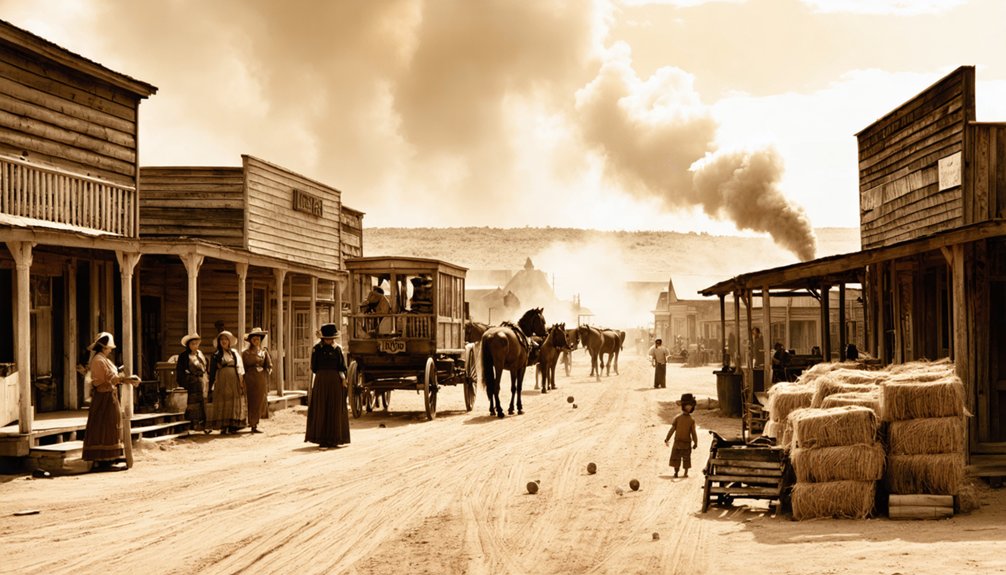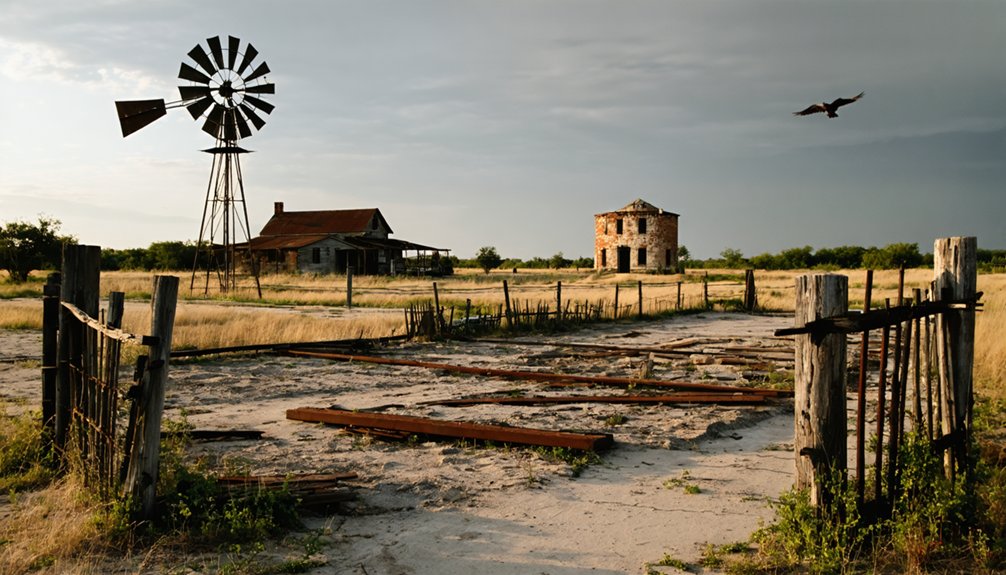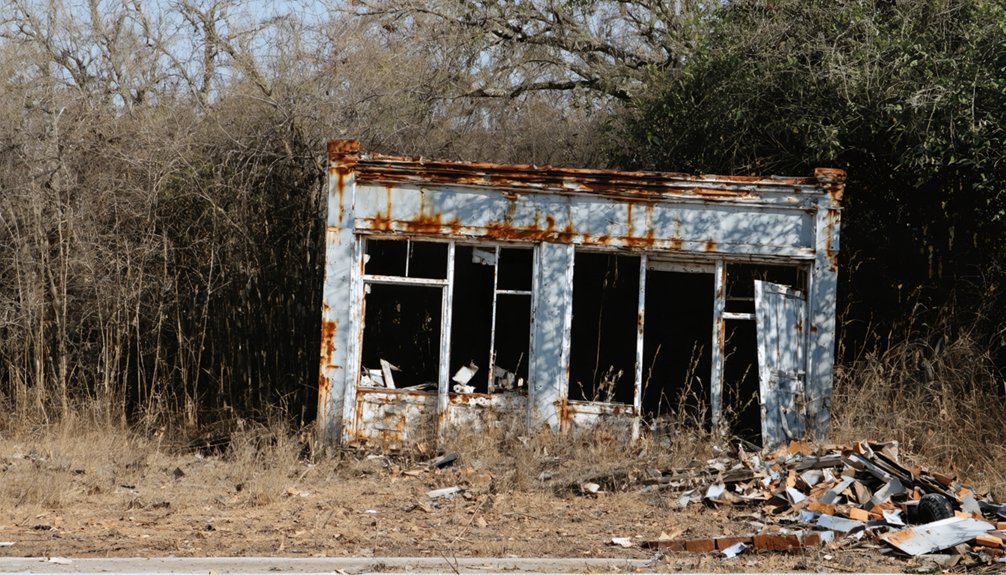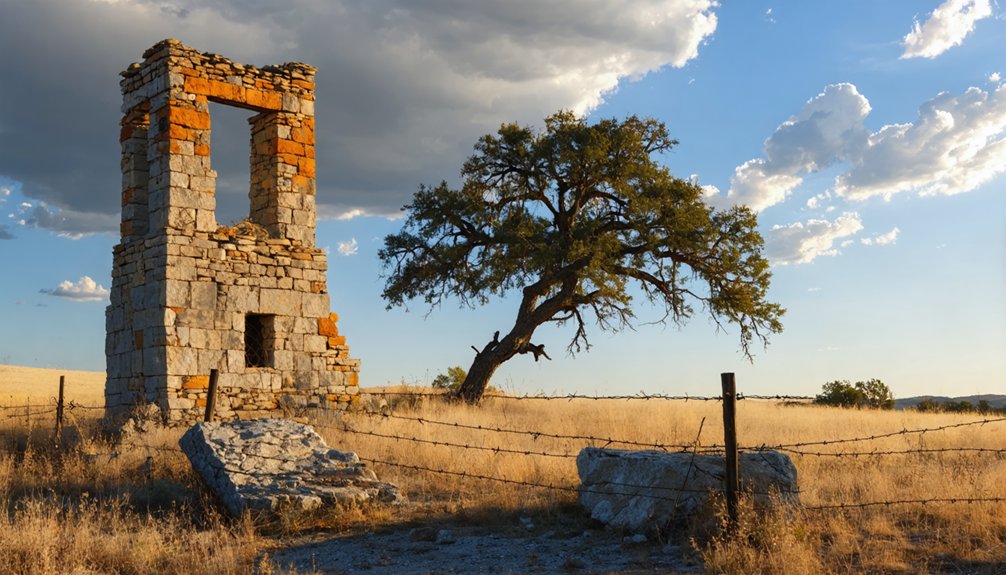You’ll find Yegua’s ghost town remnants along its namesake creek in Washington County, Texas, where settlers first arrived in the 1820s. The community thrived around John P. Coles’ mill and established a post office in 1859, serving as a crucial communication hub for local farmers and ranchers. After the post office closed in 1867, Yegua gradually declined despite its rich agricultural heritage. The story of this vanished frontier settlement reveals fascinating details about early Texas life.
Key Takeaways
- Yegua began as a frontier settlement in the 1820s along Yegua Creek, featuring early developments like John P. Coles’ mill.
- The community established vital infrastructure including a post office in 1859, which served as a central communication hub.
- The post office’s closure in 1867 marked the beginning of Yegua’s decline and loss of essential community services.
- Economic challenges intensified as younger residents moved to urban areas and the town became isolated from major transportation routes.
- The creation of Lake Somerville in 1967 transformed the area, but Yegua had already diminished into a ghost town.
The Birth of a Frontier Settlement
Along the banks of Yegua Creek, a tributary stretching 62 miles to the Brazos River, the frontier settlement of Yegua emerged in northern Washington County, Texas.
You’ll find its roots in the 1820s when Stephen F. Austin named the creek “Yegua,” Spanish for “mare,” marking the beginning of Anglo-American settlement challenges in the region.
Despite Mexican restrictions on immigration through the Law of April 6, 1830, determined settlers like Sterling C. Robertson pushed forward with frontier migration. The term “yegua” shares linguistic roots with the Yagua of Peru, who were similarly named by Spanish explorers.
Even faced with Mexico’s legal barriers, pioneers like Robertson remained resolute in their westward push across the Texas frontier.
The area’s promise drew pioneers like John P. Coles, who built a mill on the creek in 1826.
The settlement grew enough to establish a post office by 1859, taking advantage of the creek’s timber resources and natural grazing lands where mustangs once roamed freely.
The region later became notorious for its outlaw activities after the Civil War, with cattle rustling and violent confrontations plaguing the community.
Life Along Yegua Creek
You’ll find the origins of creek settlement at Yegua centered around its post office establishment in 1859, marking the community’s brief but notable existence before its closure in 1867.
The creek’s water resources played an essential role in early development, with John P. Coles constructing a mill in 1826 and the later Somerville Dam in 1967 helping to control floods while supporting agriculture and recreation. Originally named by Spanish explorers, the creek earned its name from the wild mustang mares that grazed along its banks. The dam’s construction dramatically altered the creek’s character, with small lakes forming behind numerous dams along its course.
Life in creek communities flourished around stops like Post Oak Island, where residents enjoyed amenities including a store, Masonic lodge, and stagecoach service until post-Civil War economic shifts led to their decline.
Creek Settlement Origins
The gradual settlement of Yegua Creek began in the 1820s when Anglo-American pioneers ventured south of Old San Antonio Road and north of the creek following Stephen F. Austin’s colony foundation.
Despite Mexico’s 1830 law prohibiting further Anglo settlement, determined settlers persisted, drawn by the region’s promising opportunities and abundant resources. Sterling C. Robertson settled near Fort Tenoxtitlán in November 1830, establishing an important early presence in the area.
The settlers faced constant threats from hostile tribes, with many early pioneers encountering deadly raids that tested their resilience and determination to establish permanent settlements.
- You’ll find evidence of diverse settler motivations, from Tennesseans seeking fertile farmland to Europeans pursuing religious freedom.
- The area became a hub of cultural exchanges between Anglo settlers, European immigrants, and Native American groups.
- Fort Tenoxtitlán’s establishment in 1830 marked a pivotal moment, attracting over fifty Tennesseans who settled nearby, defying Mexican restrictions.
The creek’s fertile soils, timber resources, and strategic location made it an attractive destination for those seeking independence on the Texas frontier.
Water Resources Impact
While Yegua Creek’s natural flow patterns shaped early settlement life, the construction of Somerville Dam in 1967 fundamentally transformed the region’s water resources.
You’ll find the creek flowing at a gentler pace, ideal for canoeing and kayaking adventures downstream from the dam.
The dam’s sediment retention system captures 99.8% of upper Yegua sediment, maintaining the creek basin’s equilibrium. Recent surveys have shown that aquatic vegetation loss has significantly impacted fish populations in the reservoir.
Since 2018, you’ve had the Texas Water Resources Institute monitoring water quality through regular sampling, working to protect your watershed. Their efforts focus on reducing pollutants and preserving aquatic habitats that are essential to the ecosystem’s health.
When water levels fluctuate due to droughts or floods, you’ll notice changes in the reservoir’s storage capacity and its impact on the surrounding vegetation that helps stabilize the shoreline. The creek has experienced several major flooding events throughout history, including significant floods in 1833 and 1842 that reshaped its banks and surrounding terrain.
Creek Community Life
Scattered along the banks of Yegua Creek, early settlers faced strict Mexican settlement restrictions during the 1820s and 1830s, particularly in areas south of Old San Antonio Road.
Despite these constraints, determined settlers from Tennessee, led by Sterling C. Robertson, established communities that showcased remarkable settlement diversity, including Anglo-Americans and emancipated African Americans during Reconstruction.
- You’d find thriving agricultural practices centered around John P. Coles’ mill, built in 1826.
- You could trade at local general stores while connecting to broader markets via stagecoach stops.
- You’d experience a close-knit community with its own post office, schools, and Masonic lodges.
Life along Yegua Creek meant adapting to its natural environment, with settlers making use of the creek’s timbered banks and fertile soils for farming and grazing mustang mares. The creek, originally named San Francisco by Spanish missionaries, served as a vital water source for the region’s first farming operations in 1744.
Post Office Era and Community Growth
You’ll find that Yegua’s post office, established in January 1859, served as an essential communication hub for the growing settlement along Yegua Creek.
During its eight-year operation, the post office facilitated mail service and commerce for local residents, marking a period of community development. The name similarity to the Yava or Yegua indigenous group of Peru appears to be coincidental.
The closure of postal operations in June 1867 signaled the beginning of Yegua’s decline, as the settlement lost this important piece of infrastructure that had connected it to the broader region.
Mail Service Operations
The establishment of Yegua’s post office in January 1859 marked a pivotal moment in the town’s development, serving as the primary mail distribution point near Yegua Creek in northern Washington County.
You’ll find that postal route importance grew as settlers relied on this essential communication link for trade and regional connectivity. Despite mail delivery challenges in the remote location, the post office operated successfully for eight years until June 1867.
- Connected isolated settlers to state and national networks during Texas’s integration into the U.S.
- Facilitated important trade and coordination with neighboring communities
- Served as a critical infrastructure hub in an otherwise sparsely populated rural area
The post office’s closure in 1867 noticeably impacted Yegua’s growth, ultimately contributing to its eventual transformation into a ghost town as settlers sought communities with established mail services.
Community Postal Hub Impact
While mail service operations defined Yegua’s early development, the post office’s role as a community hub shaped local growth patterns throughout its multiple operational periods.
You’ll find its postal significance extended beyond basic mail delivery, serving as a crucial nucleus for community engagement and economic activity. The facility enabled settlers to establish critical communication networks, supporting commerce and agricultural operations along Yegua Creek.
During its peak periods – from 1859 to 1867, 1900 to 1917, and 1933 to 1947 – the post office attracted additional services and businesses, though growth remained modest with only 75 residents recorded in later years.
When the post office operated, it helped maintain population stability and fostered connections with larger towns like Caldwell and Somerville, proving indispensable for the area’s rural residents.
Daily Life in 1850s Yegua

Living in 1850s Yegua demanded remarkable resilience from its inhabitants, who faced daily challenges ranging from primitive roads to outlaw threats.
You’d find yourself spending hours on daily chores like hauling water and gathering wood, while staying alert for the notorious “notch-cutters” who disrupted the area’s peace.
Despite these hardships, you’d experience strong community bonds through church gatherings, picnics, and social events that brought neighbors together.
- Your log cabin home would be simple but practical, built from local timber and limestone.
- You’d rely on newspapers like the Telegraph and Texas Register to stay informed, thanks to surprisingly high literacy rates.
- Your health would depend on home remedies and occasional visits from physicians, while battling environmental challenges like mosquitoes and contaminated water.
Agricultural Heritage and Local Economy
Established in the late 1830s near the fertile redland prairie and Yegua Creek bottom, Yegua’s agricultural roots shaped its identity as a thriving farming community.
You’d find cotton dominating the landscape until the 1930s, when agricultural practices began changing dramatically. As cotton declined due to falling prices and depleted soil, farmers turned to alternative crops like hay, sorghum, and wheat.
After World War II, you’d witness a major economic shift as livestock production overtook traditional farming. By 1982, livestock accounted for 75% of agricultural revenue.
The creation of Lake Somerville in 1967 brought stability to local farming by controlling floods and providing reliable irrigation.
St. John Baptist Church, founded in 1877, served as both a spiritual center and agricultural hub, reflecting the deep connection between community life and farming.
The Decline Years

Despite its promising beginnings, Yegua’s decline became evident after the closure of its post office in June 1867, marking the end of an eight-year period of postal service that had started in January 1859.
The town’s economic struggles intensified as its isolation from major transportation routes limited access to crucial markets and resources. Population shifts followed a pattern common to many Texas settlements, with younger residents moving to urban centers for better opportunities.
- Limited infrastructure and lack of natural resources stunted the town’s growth potential
- Environmental challenges, including unpredictable weather patterns, made agricultural sustainability difficult
- Community services gradually disappeared as the population dwindled, creating a cycle of decline
This pattern of decline transformed Yegua into one of Texas’s many ghost towns, leaving behind only traces of its former vitality.
Washington County’s Lost Town
Nestled within Washington County’s rich historical landscape, Yegua emerged as one of the county’s earliest settlements along the banks of its namesake creek.
You’ll find this lost town’s remnants in an area where clay and sandy loam soils once supported thriving plantations and farms, surrounded by majestic black willows and live oaks.
The settlement patterns around Yegua reflected the broader historical significance of Washington County, which played a pivotal role in Texas independence.
You can trace the town’s origins to the early 1840s when settlers were drawn to the fertile farmland and strategic location along water routes connecting to the Brazos River.
The area’s importance grew through steamboat navigation, though later boundary changes and the decline of cotton farming would reshape the community’s destiny.
What Remains Today

Today’s visitor to Yegua will find little evidence of the once-thriving settlement, as no original buildings or structures remain standing at the site.
The historical significance of this ghost town remains primarily in records rather than physical traces, with even the post office that operated from 1859 to 1867 having vanished completely.
Time has erased all physical remnants of Yegua, leaving only documentary traces of its brief eight-year postal service.
You’ll find the area has largely reverted to natural landscape, with Yegua Creek serving as the main geographical marker.
- The site likely contains only scattered foundations or footings, detectable through careful ground inspection
- Private land ownership may restrict access, with no public facilities or marked historical trails
- Natural reclamation has transformed most of the former townsite into pasture or overgrown terrain
Legacy in Texas Ghost Town History
Although physical remnants of Yegua have vanished, the ghost town‘s legacy endures as a significant example of 19th-century Texas settlement patterns.
You’ll find Yegua’s heritage woven into Washington County’s historical tapestry, particularly through its strategic location near Yegua Creek and its brief but notable post office operation from 1859 to 1867.
As one of Texas’s many ghost town archetypes, Yegua tells a familiar story of boom and bust that you’ll recognize throughout the state’s history.
Its relatively short lifespan mirrors countless other settlements that couldn’t sustain themselves when bypassed by railroads or struck by economic hardship.
Today, while the town itself no longer exists, Yegua’s story continues to inform our understanding of early Texas frontier life and settlement dynamics.
Frequently Asked Questions
Were There Any Notable Native American Conflicts Around Yegua?
Through mounting raids and violent clashes, you’d find Comanche and Caddo tribes engaged in conflicts around Yegua until 1841, when the last fatal Native American attack occurred in the region.
What Was the Peak Population of Yegua During Its Existence?
You won’t find official records of Yegua’s peak population in historical documents. Given its brief economic presence and short-lived post office (1859-1867), historians suggest it remained a small settlement throughout its history.
Did Any Significant Civil War Events Occur in Yegua?
You won’t find any significant Civil War events in historical records for this location. While Texas played a role in the conflict, this area didn’t experience notable military or strategic activity.
What Happened to the Original Buildings and Structures?
Like footprints in shifting sand, you’ll find no historical preservation of the original structures. Time and neglect erased all architectural remnants—they’ve either collapsed naturally or were dismantled after 1867.
Are There Any Cemetery Plots or Burial Grounds Remaining?
You won’t find documented cemetery plots or burial grounds, though local cemetery history suggests unmarked graves might exist. Given regional burial customs, any remaining sites would likely be informal and weathered.
References
- https://en.wikipedia.org/wiki/Yegua
- https://mix931fm.com/cherokee-county-ghost-towns/
- https://texashighways.com/travel-news/four-texas-ghost-towns/
- https://pplt.org/land-talk/122015/yegua-knobbswhere-life-is-always-wild
- https://en.wikipedia.org/wiki/List_of_ghost_towns_in_Texas
- https://www.wikiwand.com/en/articles/Yegua
- https://www.texasescapes.com/TOWNS/Independence/IndependenceTexas.htm
- https://www.texasescapes.com/CentralTexasTownsSouth/Longpoint-Texas.htm
- https://www.tshaonline.org/handbook/entries/burleson-county
- https://www.hmdb.org/m.asp?m=74292



